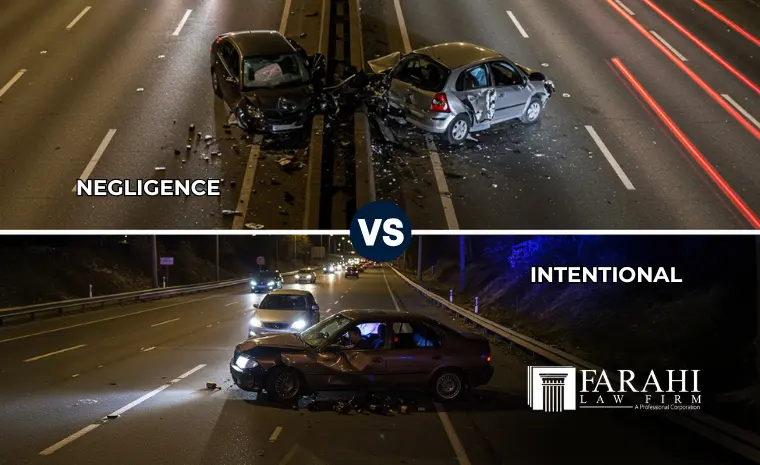Summary
Negligence and intentional injury are two separate legal concepts that influence how accident cases are handled. Negligence in personal injury typically involves careless mistakes, whereas intentional harm is deliberate. This blog explains the differences, offers real-world examples, and guides victims on how to seek justice and compensation.
Table of Contents
Every year, people across California experience accidents that lead to devastating consequences. Careless actions cause some, while others result from deliberate choices to cause harm.
Understanding the difference between intentional injury and negligence is crucial, especially if you’ve been hurt in Sacramento near landmarks like the Tower Bridge or Capitol Mall. Knowing this distinction empowers victims to hold the right parties accountable.
In this blog, we will explore key definitions, everyday scenarios, and California-specific legal implications to help you protect your rights and secure the support you deserve.
What Is Negligence in Personal Injury?

Negligence occurs when someone fails to act with reasonable care, resulting in physical harm or emotional harm to another person. Unlike intentional acts, negligence usually arises from mistakes, poor judgment, or recklessness.
Key points about negligence:
- It does not require intent.
- Victims may be entitled to compensation for medical expenses, lost income, and suffering.
- Common in motor vehicle collisions and slip and fall cases.
What Is an Intentional Injury?
An intentional injury happens when a person acts intending to cause harm. This includes physical assaults, dog attacks ordered by owners, or deliberately causing a crash. Victims often face civil lawsuits and possibly criminal charges against the offender.
In California, intentional injuries can result in higher damages because courts may award punitive damages and compensation for medical costs, therapy, and lost wages.
Everyday Examples: From Distracted Driving to Dog Bites
Negligence and intentional harm often appear in everyday life.
Negligence examples:
- Distracted driving that causes a collision
- A store owner failing to clean a wet floor
- Dog owners not securing their pets
Intentional harm examples:
- A cyclist intentionally swerving into a pedestrian
- Someone throwing an object at another person to cause injury
- A person setting a trap to harm a visitor on their property
Both negligence and intentional harm can leave victims with preventable injuries, long-term treatment needs, and mental health-related conditions.
How Liability and Damages Differ in California
California law distinguishes between negligent and intentional acts when determining liability and damages.
Factor | Negligence | Intentional Injury |
Definition | Carelessness or failure to act safely | Deliberate act to cause harm |
Examples | Motor vehicle accident from distracted driving | Assault, purposeful car crash |
Damages | Medical bills, lost income, pain, and suffering | Medical bills, emotional harm, punitive damages |
Legal Action | Civil lawsuit | Civil and criminal cases |
A Sacramento personal injury lawyer can evaluate your situation, gather evidence, and help you seek fair compensation.
Public Health Insights: Understanding the Bigger Picture
The Centers for Disease Control and Prevention (CDC) reports that unintentional injuries are a leading cause of emergency department visits across all age group categories in the U.S. They contribute to millions of emergency department admissions annually. In contrast, intentional injuries, while less common, often require long-term mental health services and medical care.
According to research, alcohol or drug abuse frequently plays a role in both negligent and intentional harm. Victims may face lasting challenges, including mental health-related conditions, which highlight the importance of legal and medical intervention.
Steps to Take if You’ve Been Harmed
If you’ve suffered from negligence or intentional injury, here are practical steps:
- Seek medical help immediately – visit emergency rooms or clinics if needed.
- Document everything – photos, witness statements, and police reports.
- Consult a Sacramento personal injury lawyer – legal guidance protects your rights.
- Consider emotional recovery – connect with mental health services if you’re experiencing trauma.
- Know your rights – compensation may include medical bills, lost wages, and damages for emotional harm.
FAQs
Negligence occurs when someone fails to act with reasonable care and causes accidental harm. Intentional harm, conversely, involves deliberate actions meant to cause injury.
Yes. In some cases, the same incident may involve careless behavior and intentional misconduct, allowing victims to pursue claims for each.
Often, yes. Because intentional acts are more serious, California courts may award punitive damages and compensation for medical costs, lost income, and pain and suffering.
Proof may come from witness statements, video evidence, or threatening or violent behavior patterns. A Sacramento lawyer can help gather and present this evidence effectively.
Standing With You Every Step of the Way
The impact can be life-changing, whether you’re dealing with negligence in personal injury or intentional injury. Victims deserve justice, compensation, and compassionate legal support. Farahi Law Firm provides free consultations to help you navigate your options.
📞 Contact us today to speak with a Sacramento personal injury lawyer and get the medical treatment you need and the money you deserve.



